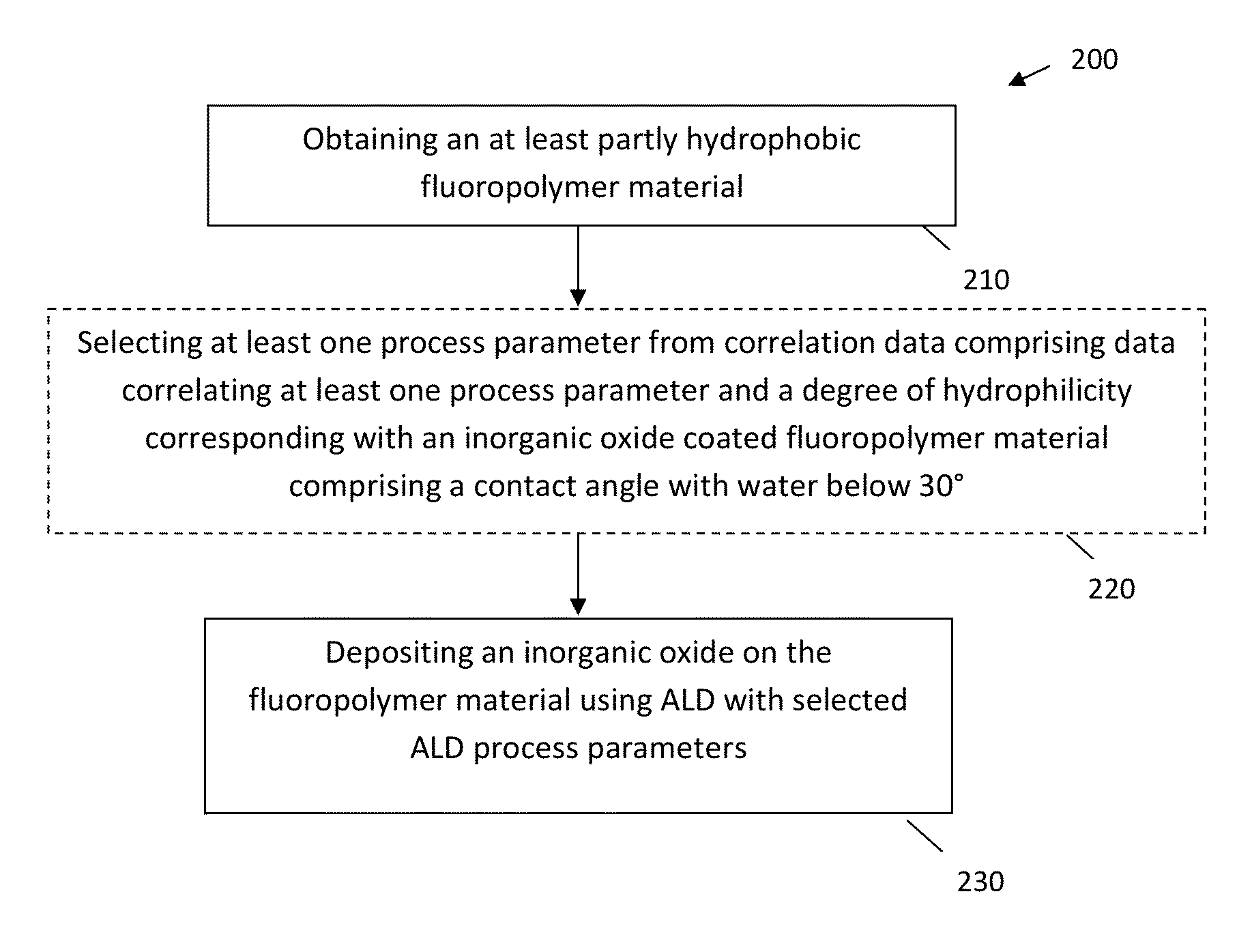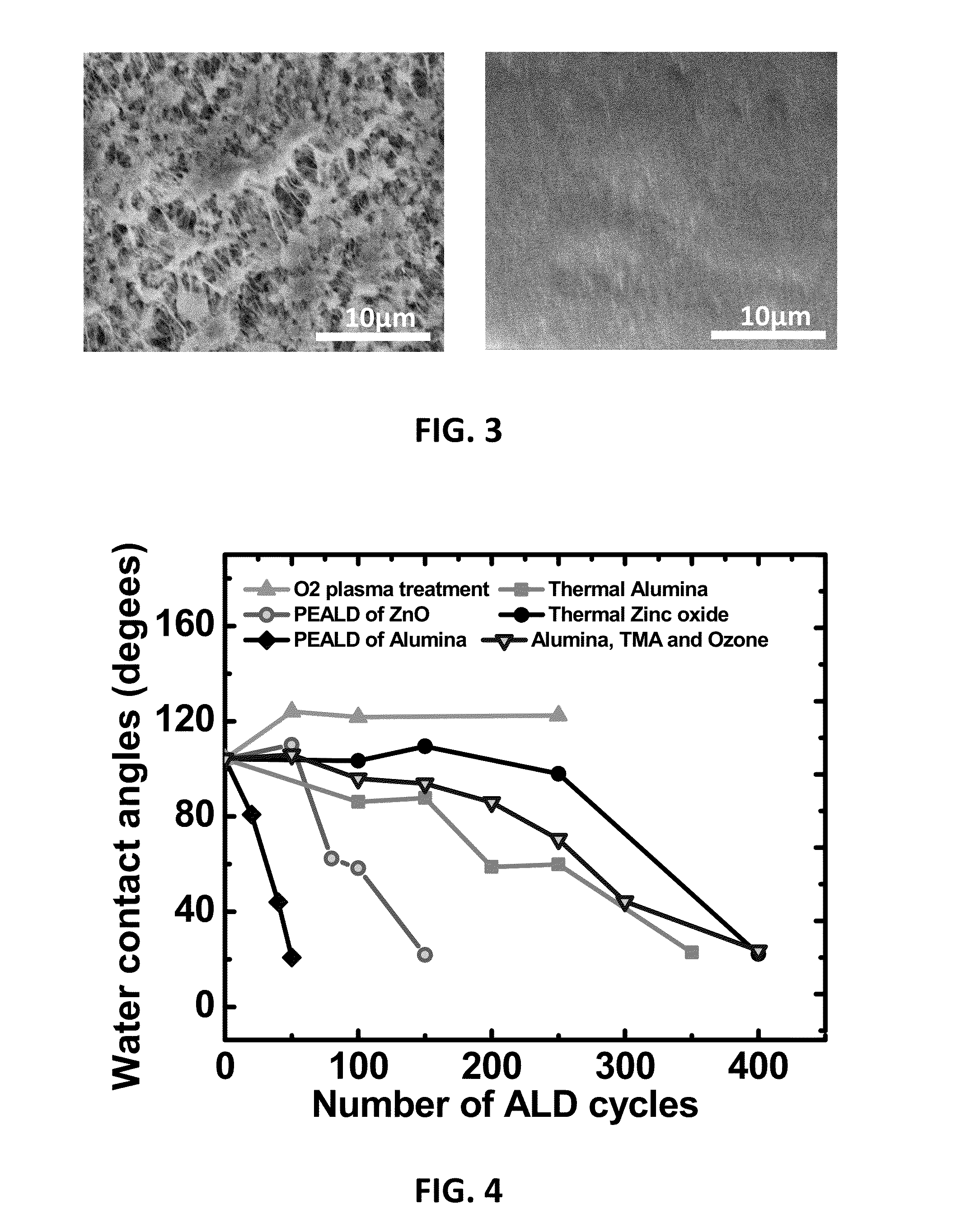Methods for Obtaining Hydrophilic Fluoropolymers
a fluoropolymer and hydrophilic technology, applied in the field of thermoplastic material processing, can solve the problems of long processing time, limited use of polytetrafluoroethylene (ptfe) in various applications, and difficulty in adhesion
- Summary
- Abstract
- Description
- Claims
- Application Information
AI Technical Summary
Benefits of technology
Problems solved by technology
Method used
Image
Examples
experiment 1
[0079]Aluminum oxide was deposited using thermal atomic layer deposition on a PTFE membrane. Thermal aluminum oxide has been deposited on PTFE by exposing the polymer to pulses of trimethylalumium (TMA) and water. The thermal depositions have been carried out at temperatures between 65° C. to 100° C. and one cycle of the process can be described as follows: A trimethylaluminum pulse with a pulse length of 2 s was applied to the PTFE material that was exposed to the pulse for 10 s. Thereafter, the remaining vapour was removed by pumping during 60 s. Following the pumping, a water vapour pulse was applied for 2 s and the PTFE material was exposed 10 s to the water vapour. For removing the water vapour, thereafter again 60 s of pumping was applied. Samples were studied for different numbers of aluminum oxide ALD deposition cycles, in the present example in the range 0 to 350 cycles. During precursor pulses, typical gas pressure inside the chamber is between 10−1 to 10−2 mbar (0.075 to ...
experiment 2
[0080]Aluminum oxide was deposited using plasma enhanced atomic layer deposition on a PTFE membrane. For the plasma enhanced atomic layer deposition of aluminum oxide a cycle of the process can be described as follows: A trimethylaluminum pulse with a pulse length of 2 s was applied to the PTFE material that was exposed to the pulse for 10 s. Thereafter, the remaining vapour was removed by pumping during 60 s. Following the pumping, an oxygen plasma treatment was applied during 6 s, followed by 30 s of pumping. The plasma power varied between 25W and 300W. Samples were studied for different numbers of aluminum oxide ALD deposition cycles, in the present example in the range 0 to 75 cycles. During precursor pulses, typical gas pressure inside the chamber is between 10−1 to 10−2 mbar (0.075 to 0.0075 Ton). Precursor exposure amounts to approximately 105L to 106 L.
experiment 3
[0081]Zinc oxide was deposited using thermal atomic layer deposition on a PTFE membrane. For thermal zinc oxide deposition diethylzinc(DEZn) and water have been used. The thermal atomic layer deposition of zinc oxide was performed at a temperature between 65° C. and 100° C. and one cycle of the process can be described as follows: A diethylzinc pulse with a pulse length of 2 s was applied to the PTFE material that was exposed to the pulse for 10 s. Thereafter, the remaining material was removed by pumping during 60 s. Following the pumping, a water vapour pulse was applied for 2 s and the PTFE material was exposed 10 s to the water vapour. For removing the water vapour, thereafter again 60 s of pumping was applied. Samples were studied for different numbers of zinc oxide ALD deposition cycles, in the present example in the range 0 to 400 cycles. During precursor pulses, typical gas pressure inside the chamber is between 10−1 to 10−2 mbar (0.075 to 0.0075 Ton). The precursor exposure...
PUM
| Property | Measurement | Unit |
|---|---|---|
| contact angle | aaaaa | aaaaa |
| contact angle | aaaaa | aaaaa |
| water contact angle | aaaaa | aaaaa |
Abstract
Description
Claims
Application Information
 Login to View More
Login to View More - R&D
- Intellectual Property
- Life Sciences
- Materials
- Tech Scout
- Unparalleled Data Quality
- Higher Quality Content
- 60% Fewer Hallucinations
Browse by: Latest US Patents, China's latest patents, Technical Efficacy Thesaurus, Application Domain, Technology Topic, Popular Technical Reports.
© 2025 PatSnap. All rights reserved.Legal|Privacy policy|Modern Slavery Act Transparency Statement|Sitemap|About US| Contact US: help@patsnap.com



